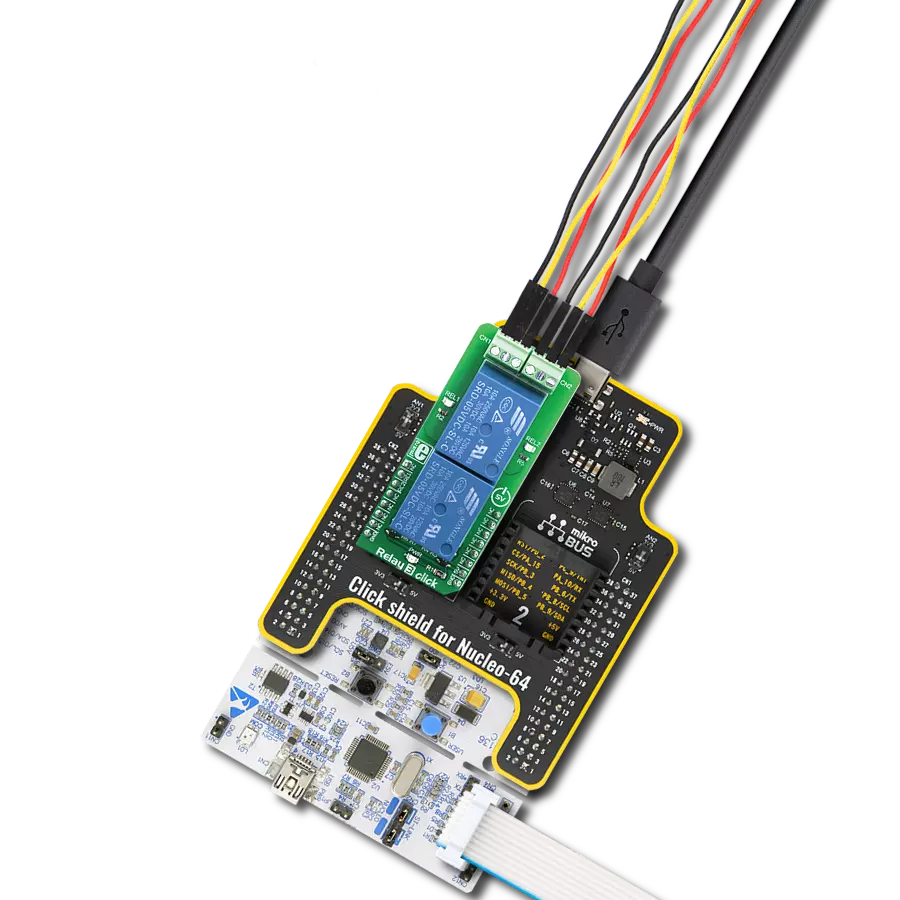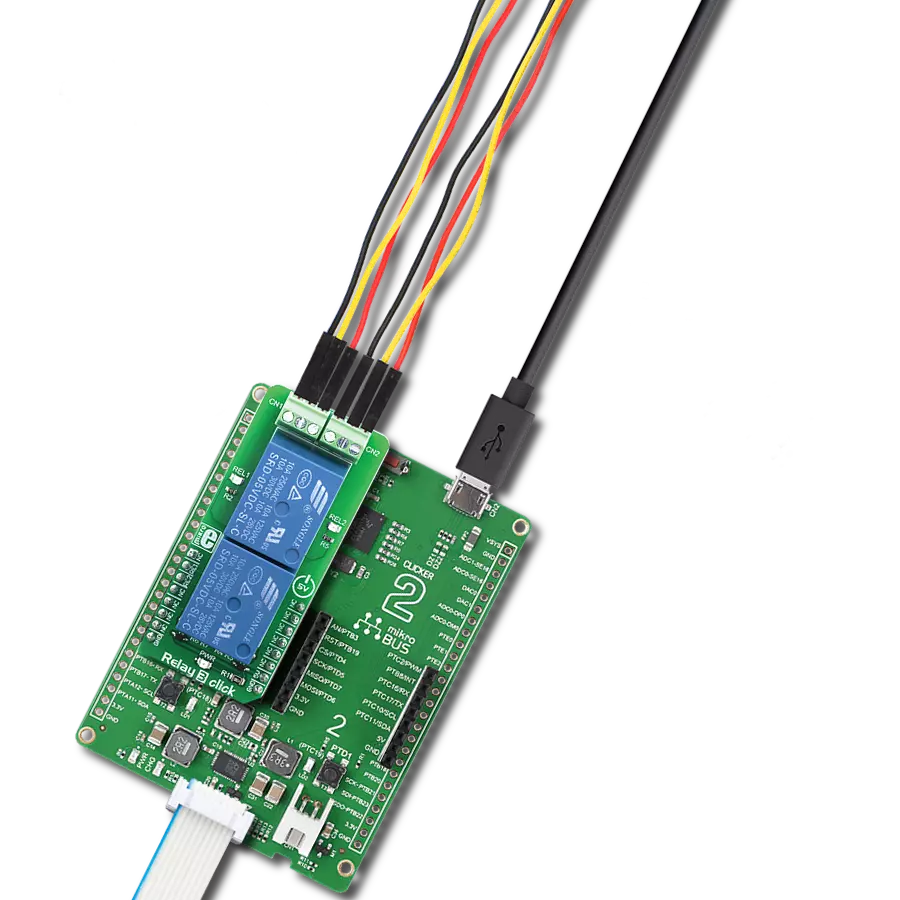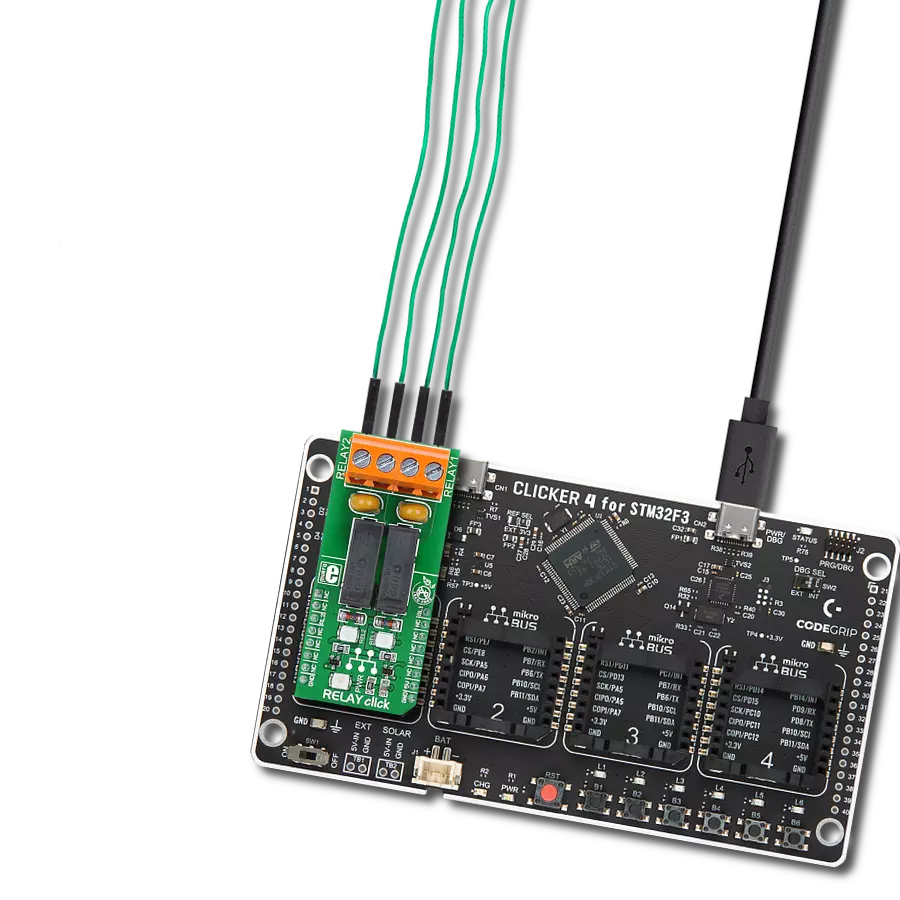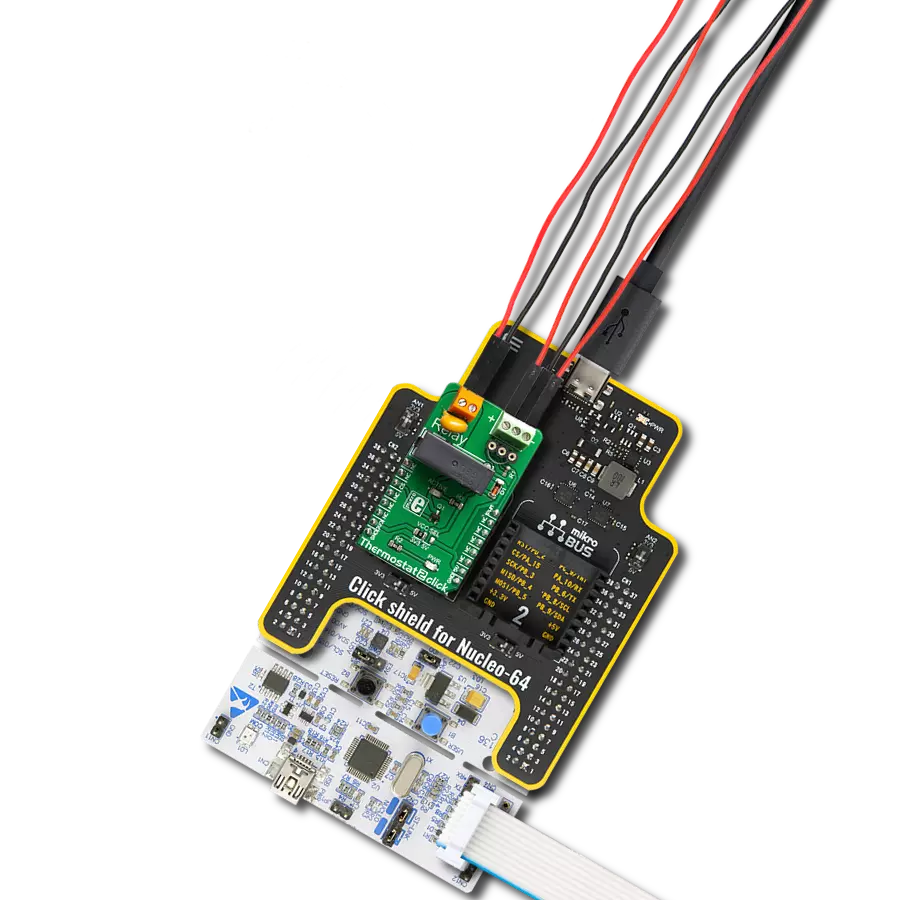Upgrade your systems with silent, spark-free switching by implementing our SPDT relay solution
A
A
Hardware Overview
How does it work?
Signal Relay Click is based on four G5V-1s, an ultra-miniature, highly sensitive single-pole double-throw (SPDT) relays for signal circuits from Omron. The G5V-1 relays feature wide switching power of up to 1A, high sensitivity with 150mW of nominal coil power consumption, and fully-sealed construction, thus offering environmental resistance. The relay internal single-type contact is made as a single crossbar of gold and silver alloy. The relay output markings of the screw terminal
are labeled at the bottom of this Click board™ with additional info. Every relay has its LED for visual presentation, labeled OUT1-4. The Signal Relay Click uses four mikroBUS™ pins labeled RE1, RE2, RE3, and RE4 to communicate with the host microcontroller. All relays are driven through small amplifier transistors as a safe solution for the relays’ current and their impact on the host MCU. The Signal Relay Click also features small signal fast switching diodes on each relay to prevent
electrical noise. One thing to note is that the relays’ coils are 5-volts driven. This Click board™ can be operated only with a 5V logic voltage level. The board must perform appropriate logic voltage level conversion before using MCUs with different logic levels. Also, it comes equipped with a library containing functions and an example code that can be used as a reference for further development.
Features overview
Development board
Arduino UNO is a versatile microcontroller board built around the ATmega328P chip. It offers extensive connectivity options for various projects, featuring 14 digital input/output pins, six of which are PWM-capable, along with six analog inputs. Its core components include a 16MHz ceramic resonator, a USB connection, a power jack, an
ICSP header, and a reset button, providing everything necessary to power and program the board. The Uno is ready to go, whether connected to a computer via USB or powered by an AC-to-DC adapter or battery. As the first USB Arduino board, it serves as the benchmark for the Arduino platform, with "Uno" symbolizing its status as the
first in a series. This name choice, meaning "one" in Italian, commemorates the launch of Arduino Software (IDE) 1.0. Initially introduced alongside version 1.0 of the Arduino Software (IDE), the Uno has since become the foundational model for subsequent Arduino releases, embodying the platform's evolution.
Microcontroller Overview
MCU Card / MCU
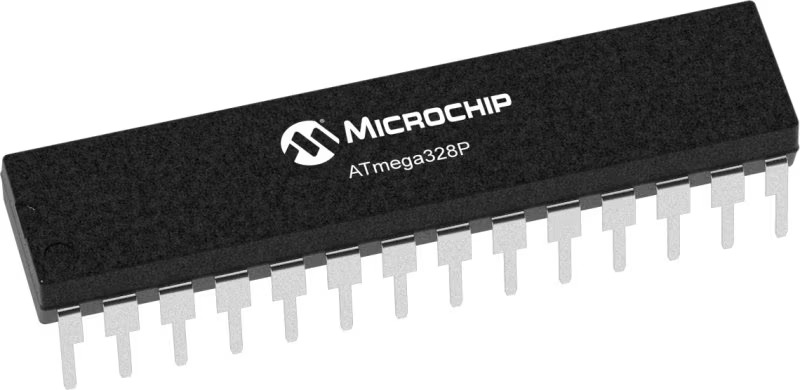
Architecture
AVR
MCU Memory (KB)
32
Silicon Vendor
Microchip
Pin count
28
RAM (Bytes)
2048
You complete me!
Accessories
Click Shield for Arduino UNO has two proprietary mikroBUS™ sockets, allowing all the Click board™ devices to be interfaced with the Arduino UNO board without effort. The Arduino Uno, a microcontroller board based on the ATmega328P, provides an affordable and flexible way for users to try out new concepts and build prototypes with the ATmega328P microcontroller from various combinations of performance, power consumption, and features. The Arduino Uno has 14 digital input/output pins (of which six can be used as PWM outputs), six analog inputs, a 16 MHz ceramic resonator (CSTCE16M0V53-R0), a USB connection, a power jack, an ICSP header, and reset button. Most of the ATmega328P microcontroller pins are brought to the IO pins on the left and right edge of the board, which are then connected to two existing mikroBUS™ sockets. This Click Shield also has several switches that perform functions such as selecting the logic levels of analog signals on mikroBUS™ sockets and selecting logic voltage levels of the mikroBUS™ sockets themselves. Besides, the user is offered the possibility of using any Click board™ with the help of existing bidirectional level-shifting voltage translators, regardless of whether the Click board™ operates at a 3.3V or 5V logic voltage level. Once you connect the Arduino UNO board with our Click Shield for Arduino UNO, you can access hundreds of Click boards™, working with 3.3V or 5V logic voltage levels.
Used MCU Pins
mikroBUS™ mapper
Take a closer look
Click board™ Schematic

Step by step
Project assembly
Software Support
Library Description
This library contains API for Signal Relay Click driver.
Key functions:
signalrelay_relay_state- Relays state
Open Source
Code example
The complete application code and a ready-to-use project are available through the NECTO Studio Package Manager for direct installation in the NECTO Studio. The application code can also be found on the MIKROE GitHub account.
/*!
* \file
* \brief Signal Realy Click example
*
* # Description
* Demo application is used to shows basic controls Signal Relay Click.
*
* The demo application is composed of two sections :
*
* ## Application Init
* Configuring Clicks and log objects.
* Settings the Click in the default configuration.
*
* ## Application Task
* Alternately sets relays to ON-OFF state...
*
* \author Katarina Perendic
*
*/
// ------------------------------------------------------------------- INCLUDES
#include "board.h"
#include "log.h"
#include "signalrelay.h"
// ------------------------------------------------------------------ VARIABLES
static signalrelay_t signalrelay;
static log_t logger;
// ------------------------------------------------------ APPLICATION FUNCTIONS
void application_init ( void )
{
log_cfg_t log_cfg;
signalrelay_cfg_t cfg;
/**
* Logger initialization.
* Default baud rate: 115200
* Default log level: LOG_LEVEL_DEBUG
* @note If USB_UART_RX and USB_UART_TX
* are defined as HAL_PIN_NC, you will
* need to define them manually for log to work.
* See @b LOG_MAP_USB_UART macro definition for detailed explanation.
*/
LOG_MAP_USB_UART( log_cfg );
log_init( &logger, &log_cfg );
log_info( &logger, "---- Application Init ----");
// Click initialization.
signalrelay_cfg_setup( &cfg );
SIGNALRELAY_MAP_MIKROBUS( cfg, MIKROBUS_1 );
signalrelay_init( &signalrelay, &cfg );
signalrelay_default_cfg ( &signalrelay );
}
void application_task ( void )
{
uint8_t cnt;
// Task implementation.
for ( cnt = 1; cnt <= 4; cnt++ )
{
log_info( &logger, " *** Relay [ %d ] ON ", cnt );
signalrelay_relay_state( &signalrelay, cnt, SIGNALRELAY_STATE_ON );
Delay_ms ( 200 );
log_info( &logger, " *** Relay [ %d ] OFF ", cnt );
signalrelay_relay_state( &signalrelay, cnt, SIGNALRELAY_STATE_OFF );
Delay_ms ( 200 );
}
}
int main ( void )
{
/* Do not remove this line or clock might not be set correctly. */
#ifdef PREINIT_SUPPORTED
preinit();
#endif
application_init( );
for ( ; ; )
{
application_task( );
}
return 0;
}
// ------------------------------------------------------------------------ END
Additional Support
Resources
Category:Relay






















